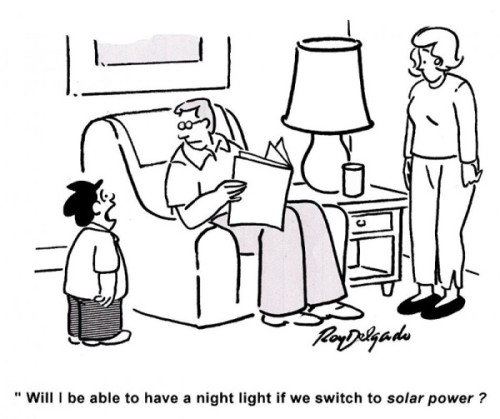It was with great fanfare that Tesla launched its home battery recently. Headlines like “Tesla launches Powerwall home battery to revolutionize energy consumption” were the norm as the public read about this revolutionary jump forward in energy storage. A recent article on where famed author Margaret Atwood is investing says it all …. “if [Tesla CEO] Elon Musk were putting his Powerwall on the market, I would certainly buy a piece of that. My feeling is that once that becomes affordable, everyone is going to do that. I think that’s definitely the wave of the future.”
After all, this is the dream. We can all generate our own electricity with clean energy and efficient solar panels and store enough of our home batteries to keep us going when the sun goes down. What can be better for our common future?
Well, in fact, just about everything.
It must be my age and my years in the energy industry that remind me of the essential attributes of electricity supply. Reliability and Economics. Yes, that’s right. For anyone who works in a modern electricity utility, that is what they focus on: delivering cost-effective, reliable electricity to users. And in today’s energy-intensive world, where we need electricity for every aspect of our hyperactive and energy-intensive lives, this is even more critical. We have all experienced temporary blackouts and know the negative impact they have. The problem, then, with renewable energy generated at home is that, at least for now, it is neither reliable nor economical. Since the announcement from Tesla, there have been several articles that explain this in detail, but of course, supporters will say that in time, all problems will be solved. And frankly, they may be right.

So let’s step back and ask ourselves a more important question – are we trying to solve the right problem? Most people have no idea what it takes to generate and deliver the electricity (the so-called “grid”) we take for granted in the modern world. In fact, many think electricity comes from the wall outlet. What we all want is that when we turn on the switch or plug in our phones, it just works. We are not in any way prepared for a world in which we say – oh, it’s cloudy, so we better not charge our iPhones today! I love the recent TV ads where BMW explained how they built their new I3 electric car in wind-powered factories. Yet, do any of us really think that on days when it is not windy, these factories sit idle? No, of course not.
In most advanced economies around the globe, we have achieved a high level of reliability in electricity supply. In fact, this is one of the measures that make an economy ‘advanced.’ The problem is that much of our electricity is generated with fossil fuels; primarily coal. (Coal continues to be the largest source of Germany’s electricity, where BMW has its factories, at nearly 50% of total supply). Along with this comes pollution and a high level of carbon emissions. Therefore, the only way to address these environmental issues is to reduce the use of fossil fuels, not to eliminate an integrated grid.
Just like being connected to the internet improves our lives, so does being connected to a reliable electricity grid. Do we really want to live a life where if it is cloudy for a few days and our batteries run dry, we do without? Of course not. Just imagine how much excess battery capacity we would each need to avoid this possibility. Even Elon Musk notes that his battery is currently for emergency backup – not for daily use – and yes, it would be great to have some reasonably economical backup when we experience an outage. But as is starting to be seen in California, where there are numerous discussions of the “duck curve,” people want it all – they want to generate their own electricity when they can, believing this is the best approach, but they also want the system to be there just in case they need it; and at a moment’s notice. The result – higher costs all around. The less the grid system is used, the more it costs to keep the infrastructure in place to make up the shortfall when needed.
The answer is simple: let’s take what works and improve it. That is a large interconnected grid that includes large-scale reliable economic generation based on nuclear power and hydro where available, supplemented by wind and solar depending upon the local availability of these resources. To be reliable and cost-effective, a system needs a generation that can run constantly, not just when the wind is blowing or the sun is shining. As storage technology improves, it can contribute to managing the intermittency of renewable generation and flattening the demand curve to enable an even larger share of nuclear generation.
Remember, our economy, and in fact, our very way of life is completely dependent upon the availability of reliable, clean, and economical electricity. So while we may dream of not needing the grid as we each generate our own electricity, what we really need is a strong,well-interconnected grid made up of reliable economic nuclear power as its workhorse, with wind, solar, and other forms of generation contributing when they can; all coupled with new forms of large scale storage to both even out demand and supply. Now t, his is more likely to be the future system.


